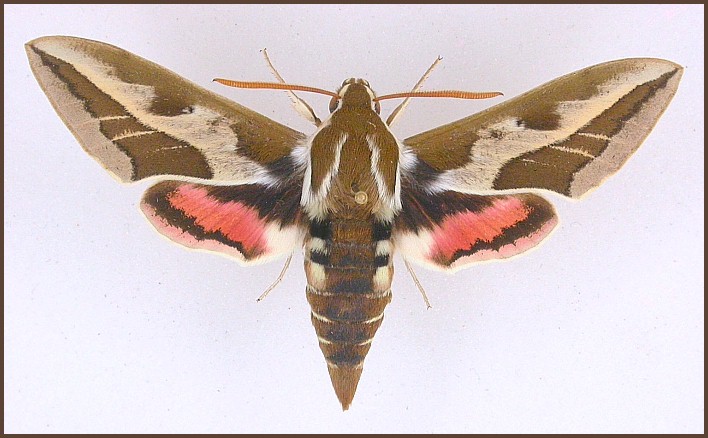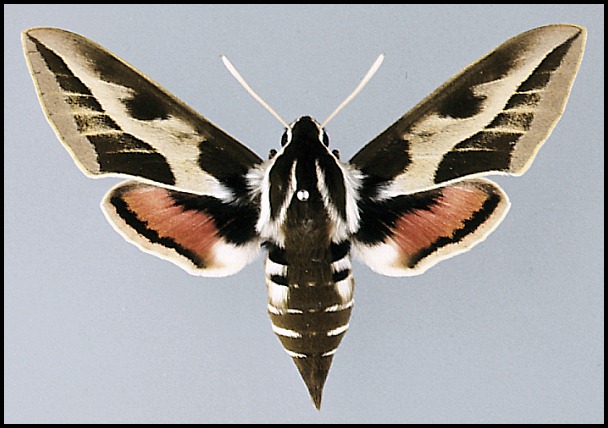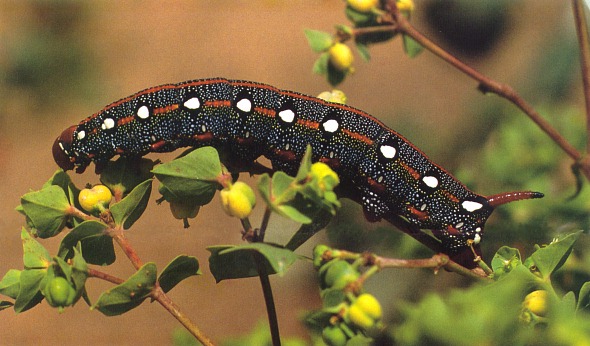UK: Barbary Spurge Hawkmoth, F: Sphinx du Tithymale
Hyles tithymali himyarensis Meerman, 1988, Ent. Ber., Amst. 48: 61--67.Type locality: Dhufar, 10 km south-east of Yarim, Dhamar Province, northern Yemen.
(Taxonomic notes. (i) Harbich (1991) treats this taxon as a subspecies of Hyles euphorbiae (Linnaeus, 1758) on the basis of a number of adult and larval characters, but fails to take into account the findings of Wiltshire (1986) and Pittaway (1987).
(ii) During the last ice age (Pleistocene) it is probable that Hyles euphorbiae was resident in the western and central parts of the Arabian Peninsula and that the Afroeremic Hyles tithymali (Boisduval, 1834) had penetrated as far east as what is now Yemen; the present-day eastern limit of its main area of distribution is in western and northern Egypt (Lewandowski & Lewandowski-Krenz, 2014). Today, Hyles tithymali himyarensis forms a disjunct eastern population, with adults resembling dark forms of Hyles tithymali deserticola (Staudinger, 1901) (Meerman, 1991). This relationship is supported by the mtDNA work of Hundsdörfer et al. (2005b). Some also resemble those of the disjunct, montane population of Hyles euphorbiae which occurs from Taif to Abha in south-western Saudi Arabia and which can tentatively be referred to Hyles euphorbiae conspicua (Rothschild & Jordan, 1903), being almost indistinguishable from the high-altitude population of that subspecies in the Lebanon. There is little overlap between these two populations of Hyles tithymali and Hyles euphorbiae, although what appear to be hybrids do occur on the Yemen border south of Abha. Semi-integrated hybrid populations between these two species can also be found on Crete (Meerman & Smid, 1988) and Malta (Pittaway, 1993), but Hyles tithymali himyarensis is certainly a good subspecies, with little interbreeding between it and Hyles euphorbiae conspicua.
(iii) Larvae of Hyles euphorbiae conspicua from Baha in Saudi Arabia are very similar to those found in the mountains of Lebanon and are hardly distinguishable from central European examples (Pittaway, in Wiltshire, 1986). In larvae of Hyles tithymali himyarensis from Yemen, the white dorso-lateral eye-spots are smaller and a pronounced orange-yellow longitudinal line develops between them, a character of Hyles tithymali. The small, pale spots immediately below this line are pale yellow (as opposed to white), indicating the presence of a masked yellow band, also characteristic of Hyles tithymali. The extensive dark coloration of larvae of the Arabian populations of both Hyles euphorbiae and Hyles tithymali may be a protective adaptation to high ultra-violet radiation levels experienced at altitude. Alternatively, it may assist heat absorption. It is interesting to note that in hybrids between Hyles tithymali and Hyles euphorbiae obtained by Harbich (1988), the adults resemble Hyles tithymali whereas the larvae look like those of Hyles euphorbiae.)
Holarctic; western Palaearctic region. Pleistocene refuge: Monocentric -- combined Afroeremic and Yemeni refugia as part of a mauretanica/deserticola complex. Part of the present day relict Saharo-Arabian faunal element confined to the highlands of the south-western Arabian peninsula. Another Saharo-Arabian species, the butterfly Papilio saharae Oberthür, 1879, has also undergone isolation and subspeciation in these same mountains since the Pleistocene (Pittaway et al., 1994).


Wingspan: 60--80mm. As illustrated. Very similar in appearance to Hyles tithymali deserticola, with which it could easily be confused. However, some individuals resemble those of the population of Hyles euphorbiae conspicua to the north.
Confined to the narrow juniper forest zone of the highlands of Yemen, at 2000--2500m. Males come readily to light and are avid visitors to flowers.
April to September, in two or three broods.
OVUM. As Hyles tithymali tithymali.
LARVA: Full-fed, 70--80mm.

Similar in some respects to Hyles dahlii (Geyer, [1828]) in that in the final instar it is sooty black and covered with fine white spots. Superimposed on this primary colour scheme is a dorso-lateral row of single, very white eye-spots set in an orange-yellow stripe. The small, pale spots immediately below this line are pale yellow (as opposed to the remainder, which are white), indicating the presence of a masked yellow band. The horn, head, prolegs, true legs and dorsal stripe are orange-yellow or red, and there is an orange and yellow chequered ventro-lateral line.
Occurs from April until October.
Major Hostplants. Herbaceous Euphorbia spp., especially Euphorbia cyparissioides.
Minor Hostplants. Euphorbia peplus.
PUPA: As Hyles euphorbiae, but with a much greater tendency to remain in this stage for two or more years.
None recorded.
Restricted to the mountains of Yemen.
Extra-limital range. None.
 Return to species list
Return to species list